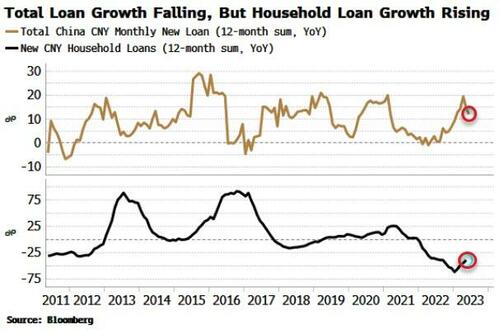
Authored by Simon White, Bloomberg macro strategist,
Stimulus in China is not yet getting through as loan growth declines and money growth stalls, increasing the likelihood policy makers ease further, and driving a re-acceleration in global inflation.
Loan data from China released today superficially showed a “beat” on the month. But month-on-month data is noisy and seasonal, the clearest way to look at it is the percentage change of the 12-month sum. This way we can see the trend, which for total CNY loans is down.
It is loans to non-financial enterprises and government loans that is driving total loans lower. One bright spot is that household-loan growth is rising (but is still negative). China’s pandemic policies, which favored state-owned enterprises at the expense of the household sector, further widened imbalances in the economy.
The low-hanging fruit from export-led growth has been plucked, and mercantile-driven growth has had to be increasingly supplemented by debt to meet targets. Now China is reluctant to stimulate in too carefree a manner as they are increasingly concerned about financial stability. Thus the rise in household-loan growth is a positive sign, but it is not enough to arrest the overall anemic recovery in China.
A principal area of weakness is the property market. It’s a major source of wealth and saving for the household sector in an economy with few alternatives and a closed capital account (at least to most people). It will be difficult to rejuvenate the household sector – and therefore the economy overall – without a rehabilitation of the property market.
Yet despite a series of easing measures, such as aid for developers, with further measures said to be imminent, the property market remains quagmired.
Real-estate transaction growth continues to slide, while floor-space started is contracting at over 6% per year, near series lows.
Furthermore, real-estate debt, after recovering early this year, is falling again, and is on track to make new lows, with USD HY debt having lost almost three-quarters of its value.
China’s binding constraint is unemployment. If growth deteriorates to the point where unemployment begins to rise sharply (youth unemployment is already over 20%, due to the weaker services sector in the pandemic, and a skills mismatch, according to Goldman Sachs), it’s likely China will reach for the hard-liquor, and stimulate – both fiscally and monetarily – much more freely.
This is likely to fuel a re-acceleration in US and global inflation. We’re not there yet, but the more disappointing data we see, the closer we will be.
Authored by Simon White, Bloomberg macro strategist,
Stimulus in China is not yet getting through as loan growth declines and money growth stalls, increasing the likelihood policy makers ease further, and driving a re-acceleration in global inflation.
Loan data from China released today superficially showed a “beat” on the month. But month-on-month data is noisy and seasonal, the clearest way to look at it is the percentage change of the 12-month sum. This way we can see the trend, which for total CNY loans is down.
It is loans to non-financial enterprises and government loans that is driving total loans lower. One bright spot is that household-loan growth is rising (but is still negative). China’s pandemic policies, which favored state-owned enterprises at the expense of the household sector, further widened imbalances in the economy.
The low-hanging fruit from export-led growth has been plucked, and mercantile-driven growth has had to be increasingly supplemented by debt to meet targets. Now China is reluctant to stimulate in too carefree a manner as they are increasingly concerned about financial stability. Thus the rise in household-loan growth is a positive sign, but it is not enough to arrest the overall anemic recovery in China.
A principal area of weakness is the property market. It’s a major source of wealth and saving for the household sector in an economy with few alternatives and a closed capital account (at least to most people). It will be difficult to rejuvenate the household sector – and therefore the economy overall – without a rehabilitation of the property market.
Yet despite a series of easing measures, such as aid for developers, with further measures said to be imminent, the property market remains quagmired.
Real-estate transaction growth continues to slide, while floor-space started is contracting at over 6% per year, near series lows.
Furthermore, real-estate debt, after recovering early this year, is falling again, and is on track to make new lows, with USD HY debt having lost almost three-quarters of its value.
China’s binding constraint is unemployment. If growth deteriorates to the point where unemployment begins to rise sharply (youth unemployment is already over 20%, due to the weaker services sector in the pandemic, and a skills mismatch, according to Goldman Sachs), it’s likely China will reach for the hard-liquor, and stimulate – both fiscally and monetarily – much more freely.
This is likely to fuel a re-acceleration in US and global inflation. We’re not there yet, but the more disappointing data we see, the closer we will be.
Loading…







